
USS Halibut (SS-232), a Gato-class submarine, was the first ship of the United States Navy to be named for the halibut, a large species of flatfish.

USS Amberjack (SS-219) was a Gato-class submarine, the first United States Navy ship named for the amberjack.

USS Sailfish (SS-192), was a US Sargo-class submarine, originally named Squalus. As Squalus, the submarine sank off the coast of New Hampshire during test dives on 23 May 1939. The sinking drowned 26 crew members, but an ensuing rescue operation, using the McCann Rescue Chamber for the first time, saved the lives of the remaining 33 aboard. Squalus was salvaged in late 1939 and recommissioned as Sailfish in May 1940.

USS Sculpin (SS-191), a Sargo-class submarine, was the first ship of the United States Navy to be named for the sculpin.

USS Harder (SS-257), a Gato-class submarine, was the first ship of the United States Navy to be named for the Harder, a fish of the mullet family found off South Africa. One of the most famous submarines of World War II, she received the Presidential Unit Citation. Her commanding officer throughout her service, the resolute and resourceful Commander Samuel D. Dealey (1906–1944), "a submariner's submariner", was posthumously awarded the Medal of Honor, as well as four Navy Crosses during his lifetime.
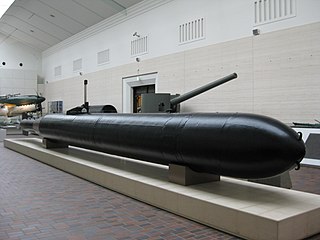
Kaiten were crewed torpedoes and suicide craft, used by the Imperial Japanese Navy in the final stages of World War II.

Lieutenant Commander Malcolm David Wanklyn, was a Royal Navy commander and one of the most successful submariners in the Western Allied navies during the Second World War. Wanklyn and his crew sank 16 enemy vessels.

Agano (阿賀野) was the lead ship of her class of four light cruisers built for the Imperial Japanese Navy (IJN) during World War II. Completed in 1942, she escorted a troop convoy to New Guinea in December. In early 1943 the ship participated in Operation Ke, the evacuation of Japanese troops from Guadalcanal. Six months later Agano transported troops and supplies to New Guinea and she played a minor role in the Battle of Empress Augusta Bay in early November. A few weeks later, the ship was badly damaged by American airstrikes and she sailed for Truk under her own power the following day. While en route, Agano was torpedoed by an American submarine and had to be towed to her destination. After several months of repairs, she left for Japan, but was intercepted and sunk by another American submarine in February 1944. Most of her crew was rescued by her escorting destroyer, but that ship was sunk with the loss of most of her crew and all of Agano's survivors by an American airstrike the following day.
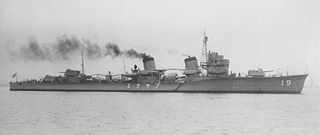
Ayanami was the eleventh of twenty-four Fubuki-class destroyers, built for the Imperial Japanese Navy following World War I. When commissioned, these ships were the most powerful destroyers in the world. They served as first-line destroyers through the 1930s, and remained formidable weapons systems well into the Pacific War.

Uranami was the tenth of twenty-four Fubuki-class destroyers, built for the Imperial Japanese Navy following World War I. When introduced into service, these ships were the most powerful destroyers in the world. They served as first-line destroyers through the 1930s, and remained formidable weapons systems well into the Pacific War.

Sendai was a Sendai-class light cruiser in the Imperial Japanese Navy. She was named after the Sendai River in southern Kyūshū. Sendai was the lead ship of the three vessels completed in her class of light cruisers, and like other vessels of her class, she was intended for use as the flagship of a destroyer flotilla.
German submarine U-405 was a Type VIIC U-boat of Nazi Germany's Kriegsmarine during World War II.

The Battle of the Caribbean refers to a naval campaign waged during World War II that was part of the Battle of the Atlantic, from 1941 to 1945. German U-boats and Italian submarines attempted to disrupt the Allied supply of oil and other material. They sank shipping in the Caribbean Sea and the Gulf of Mexico and attacked coastal targets in the Antilles. Improved Allied anti-submarine warfare eventually drove the Axis submarines out of the Caribbean region.
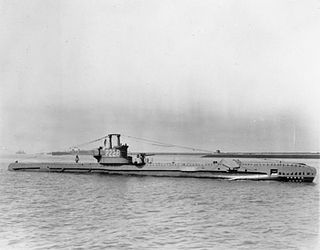
HMS Splendid was a third-batch S-class submarine built for the Royal Navy during World War II. She was laid down on 7 March 1941 and launched on 19 January 1942. After an initial patrol through the Bay of Biscay to Gibraltar, Splendid conducted two patrols in the Mediterranean Sea; one was abandoned after technical problems and on the other she sank two Italian ships. On her next patrol, the submarine attacked two Italian convoys, sinking an Italian destroyer in the second attack. Based in Algiers, the boat operated north of Sicily, sinking six Italian ships, including two tankers and two heavy merchant ships. Splendid was detected by a German destroyer on 21 April 1943 while patrolling off Naples, Italy; the submarine was attacked with depth charges by the destroyer and forced to surface, after which she was scuttled and her surviving crew members taken prisoner. She was the most successful British submarine by tonnage sunk between November 1942 and May 1943.

Convoy SC 94 was the 94th of the numbered series of World War II Slow Convoys of merchant ships from Sydney, Cape Breton Island, Nova Scotia, to Liverpool. The ships departed Sydney on 31 July 1942 and were met by Mid-Ocean Escort Force Group C-1.

The action of 8 June 1945, sometimes called the Sinking of Ashigara was a naval action that resulted in the sinking of the heavy cruiser Ashigara of the Imperial Japanese Navy by the British Royal Navy submarine HMS Trenchant. Ashigara was transporting Japanese troops from Dutch East Indies for the defence of Singapore, and the sinking resulted in a heavy loss of life.

United States Navy operations during World War I began on April 6, 1917, after the formal declaration of war on the German Empire. The American navy focused on countering enemy U-boats in the Atlantic Ocean and the Mediterranean Sea while convoying men and supplies to France and Italy. Because of United States's late entry into the war, her capital ships never engaged the German fleet and few decisive submarine actions occurred.
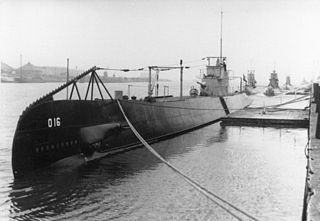
HNLMS O 16 was a submarine of the Royal Netherlands Navy that saw service during World War II. She was the first submarine of the RNN manufactured from high-quality Steel 52, with the ability to dive at a depth of 80 metres (260 ft).
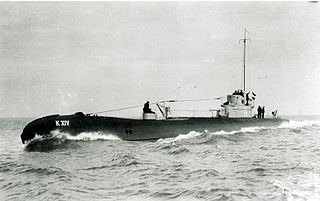
K XIV was one of five K XIV-class submarines built for the Royal Netherlands Navy. She served during World War II.

HNLMS Van Nes was a Admiralen-class destroyer of the Royal Netherlands Navy, named after the 17th century Dutch admiral Jan Jansse van Nes. She served during World War II.



















